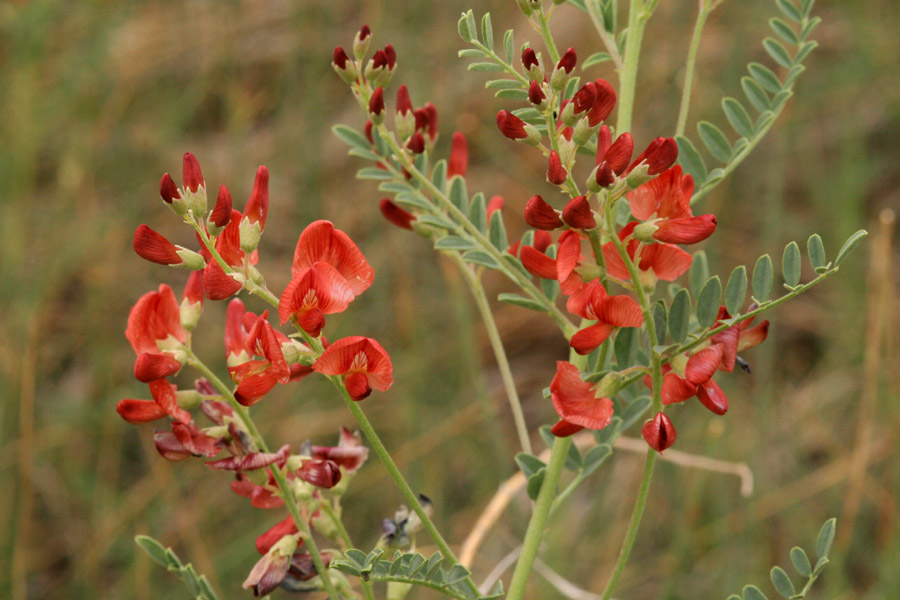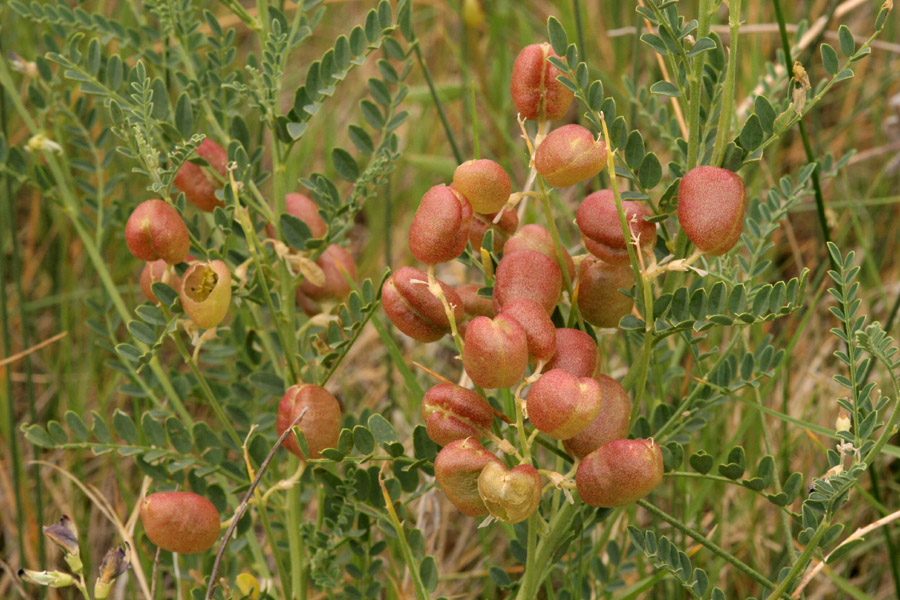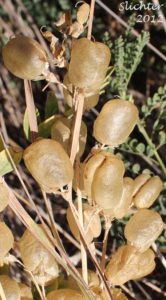Scientific name: Sphaerophysa salsula
Suggesting pronunciation: S-fair-ee-o-FY-sa sal-SU-la
Common names: swainsonpea, Austrian pea, red bladder-vetch
Family: Fabaceae (pea family)
By Jeanne Gozigian
Last spring was the first time I saw this pretty, deep red/orange/maroon flower growing along the walking path of my community lying along the Rio Grande Bosque. Hmmm, I thought: Looks like Fabaceae (pea family) from the many, small opposite leaves, covered with hair, and odd shaped blossoms. I sent off a picture to Janice Tucker and Helen Woody, my intrepid plant detective friends and proofreaders.

Photo by Patrick Alexander, SEINet – Arizona – New Mexico Chapter. 2020. http//:swbiodiversity.org/index.php . Accessed on July 30.
We agreed that this was probably swainsonpea, but left the definite identification until I was able to see the ¾ to 1 ½ inch bladder -shaped, translucent seed pods, typically forming in September. The intense heat this year saw the usual flowering, from May to July, accelerated, with seed pods fully formed by late June.

Photo by Patrick Alexander, SEINet – Arizona – New Mexico Chapter. 2020. http//:swbiodiversity.org/index.php . Accessed on 8/26/2020.
I determined that I should feature it now, while I had pictures. Who knows what will happen next to wildflowers in our bizarre climatic conditions? To the credit of swainsonpea, it is featured in Weeds of the West, so unlikely to perish. It is one of many plants introduced from Asia, flourishing along fences and roadsides in the dry states of the west. No rain? No problem!
Wouldn’t you guess that swainsonpea is named for Isaac Swainson (1746-1812), another in the famous group of English physician/botanists? He kept a private botanic garden in Twickenham, outside of London.
 The coin-like seed pods, with attachment indentation, are a threat to alfalfa seeds, a major feed source for cattle and horses. They are impossible to separate from alfalfa seeds because they are the same shape, weight and size, thus being a contaminant and the reason why this plant is listed as invasive in many western states.
The coin-like seed pods, with attachment indentation, are a threat to alfalfa seeds, a major feed source for cattle and horses. They are impossible to separate from alfalfa seeds because they are the same shape, weight and size, thus being a contaminant and the reason why this plant is listed as invasive in many western states.
S. salsula is an herbaceous, perennial sub-shrub that attains 2-5 feet in height. It is very tolerant of alkaline substrates. Introduced to the North American continent, its drought-hardy characteristics have acclimatized very well to the dry regions of the western United States.
The pinnate compound leaves occur on 5 -foot stems with no petioles. There are 15-23, one –inch long leaflets, on each leaf stalk. The ¼-1 inch long pea-shaped flowers are in racemes of 6-16 at the ends of axillary stems.
Like many in the Fabaceae family, this plant has nitrogen fixing properties from its roots. But that is not all. Endophytes, specifically the bacterium, Paracoccus sphaerophysae, reside in the roots, usually as parasites, living inside other plants. Extraordinary compounds can be produced by endophytic microbes. For example, Taxol, a billion- dollar anti-cancer drug and Munumbicins, a wide-spectrum antibiotic, are derived from these amazing endophytes. It is thought that these microbes are transmitted from the seed via the vascular system to other plant parts, then to the rhizosphere, the soil surrounding the plant roots. Perhaps there is influence for plant growth promotion:
- Phytostimulation – protection of phytohormones
- Biofertilization- nitrogen fixation
- Biocontrol – protection from phytopathogens
The very hard -coated seeds are dispersed in the seed pods. They must be scarified to germinate. They can survive for many years in seed banks, as do many in the pea family.
We could go on forever with other fascinating stories from the Plant Kingdom, but there is not enough space for them in this venue. If the subject flags your interest, check out some of the sources that are listed here. Happy researching!
Thanks to Janice Tucker and Helen Woody for proofreading this article.
Sources:
Gaiero, Jonathan R., McCall, Crystal A., Thompson, Karen A., Day, Nicola J., Best, Anna S., Dunfield, Kari E. Inside the root microbiome: Bacterial root endophytes and plant growth promotion. American Journal of Botany – Wiley Online Library. 01 Sep 2013. Web. Jul 2020. Retrieved from: https://bsapubs.onlinelibrary.wiley.com/doi/full/10.3732/ajb.1200572.
Definition of Endophyte. dictionary.com. 2020. Web. 2020. Jul 2020. Retrieved from: https://www.dictionary.com/browse/endophyte?s=t.
“Sphaerophysa salsula (Swainsonpea)”. USDA, NRCS. 2020. The PLANTS Database (http://plants.usda.gov, July 2020). National Plant Data Team Greensboro, NC 27401-4901 USA.
“Swainsonpea (Sphaerophysa salsula)”. State of Nevada Department of Agriculture. Web. 2019. May 2020. Retrieved from: http://agri.nv.gov/Plant/Noxious_Weeds/WeedList/Swainsonpea_(Sphaerophysa_salsula)/.
“Swainsonpea”. Colorado Department of Agriculture-Conservation Series. Web. 2019. Jul 2020. Retrieved from: www.colorado.gov/pacific/agconservation/swainsonpea.
“Swainsonpea, Alkali Swainsonpea. Sphaerophysa salsula (Pall.) D.C.” Missouri State University. Web. Jul 2020. Retrieved from: https://courses.missouristate.edu/pbtrewatha/swainsonpea.htm.
“Sphaerophysa salsula”. Wikipedia. Web. 24 Mar 2019. Jul 2020. Retrieved from: https://en.wikipedia.org/wiki/Sphaerophysa_salsula.
Stearn, William T., Stearn’s Dictionary of Plant Names for Gardeners, Cassell Publishers Limited, Villiers House 41/47 Strand, London WC2N5JE, copyright 1972,1992. Print.
Plant Science and Plant Pathology. What is an Endophyte? Montana State University. Web. July 2020. Retrieved from: https://plantsciences.montana.edu/facultyorstaff/faculty/strobel/endophytes.html.
Whitson, Tom D. Editor, Burrill, Larry C., Dewey, Steven A., Cudney, David W., Nelson, B. E., Lee, Richard D., Parker, Robert. Weeds of the West, published by The Western Society of Weed Science and the Western United States Land Grant Universities Cooperative Extension Services, 5th Edition, 1996. Print.


